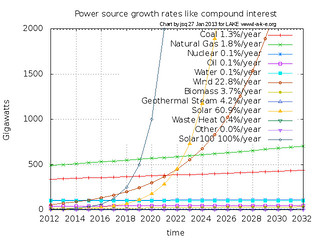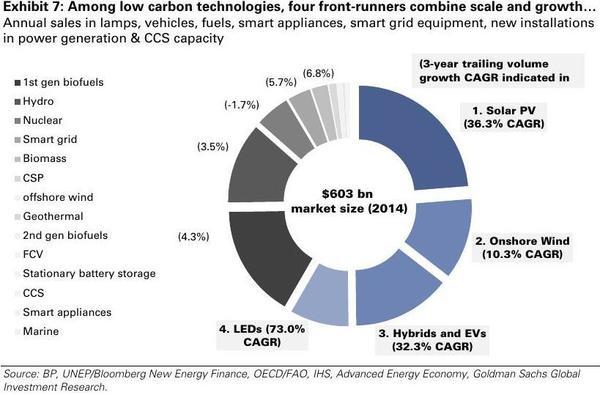Solar PV, onshore wind, electric vehicles, and LED lighting will win for all of us and profit in the next five years, says Goldman Sachs, which just put $150 billion of its own money where its mouth is. How about you, world leaders gathered in Paris?
Chris Martin, BloombergBusiness, 30 November 2015, Wind, Solar Power to Supply More Energy Than Shale, Goldman Says,
New wind turbines and solar panels worldwide will provide more energy over the next five years than U.S. shale-oil production has over the past five, according to Goldman Sachs Group Inc.
The leading renewable-energy technologies will add the equivalent of 6.2 million barrels of oil a day to the global energy mix, exceeding the 5.7 million barrels a day pumped from U.S. shale oil wells since 2010, analysts including Brian Lee and Jaakko Kooroshy said in a research report Monday….
“Wind and solar are on track to exceed 100 gigawatts in new installations for the first time,” the analysts wrote. Solar and wind energy are saving a gigaton of carbon dioxide emissions annually and the market for four leading low-carbon technologies is now worth more than $600 billion per year. “We identify LEDs, solar PV, onshore wind and hybrid and electric vehicles as clear front-runners in the emerging low-carbon economy.”
So not only is fixing climate change profitable, as Citi said, we are indeed already getting on with it, because profit.
 It’s almost as if somebody had predicted this years ago.
Oh, wait, former TVA CEO S. David Friedman,
former FERC Chair Jon Wellinghof,
and, well, me did.
With
the actual solar deployment figures from eia and FERC showing Wellinghoff
was a tad too conservative in his projection of solar deployment doubling every two years.
It’s almost as if somebody had predicted this years ago.
Oh, wait, former TVA CEO S. David Friedman,
former FERC Chair Jon Wellinghof,
and, well, me did.
With
the actual solar deployment figures from eia and FERC showing Wellinghoff
was a tad too conservative in his projection of solar deployment doubling every two years.
Solar power will win like the Internet did. They cloudy day doesn’t last for an entire month and the skies are clearing so we can see the sun and wind supplying all the power we need.
What they’re quibbling over in Paris is how fast sun and wind will win. And if world “leaders” get off the duffs they’ve been sitting on while Malaysia burns and island nations disappear into the sea (to be followed by Miami, New Orleans, Boston, and many others), the change will come faster. Targets way out in 2030 and 2050 are great, although the targets being set are way too low, unless they’re for powering the whole world with sun, wind, and water by 2050.
The world is already moving ahead, because fixing climate change is profitable. It will move faster if we stop approving any new fossil fuel projects, stop subsidizing fossil fuel companies, and actively promote solar and wind power. Those things the elected officials gathered in Paris can make happen.
Goldman Sachs is putting its money where its mouth is, by quadrupling its investment in wind and sun power to $150 billion, according to Katie Fehrenbacher, Fortune, 2 November 2015. It’s time for those gathered in Paris to do something. For example:
At the same time, the market for solar and wind technologies could take a hit in the U.S. in 2017. An important federal initiative that gives residents and businesses a 30% tax credit for installing renewable energy systems is set to expire at the end of 2016 and will be replaced by a 10% credit. While the tax credit could be extended by Congress, it’s still causing uncertainty in the clean energy markets in the U.S.
That tax credit is a drop in the bucket compared to ongoing subsidies for fossil fuels. Stop some of those and pay for that 30% for many years. Or cancel a few F-35s. When the U.S. and the world runs on sun, wind, and water, there will be no need for wars for oil or gas in the middle east anyway.
This appears to be the Goldman report descibed in the BloombergBusiness article: The Low Carbon Economy: GS SUSTAIN equity investor’s guide to a low carbon world, 2015-25. It tries to make a case for switching from coal to “natural” gas, but fails, admitting that only sun, wind, electric vehicles, and LEDs have the market size, scale, growth, interactions, and policy opportunities to profit and rapidly make a difference. It notes batteries could help with all that, and smart grid. Biofuels have lost support, hydro has no more rivers to dam, and nuclear is alrady losing percentage of global power generation. It notes half of all greenhouse gas emissions come from two main sectors: electricity and heat, and transportation, so obviously those are the main places to save. Other big sectors are “chemicals, metals, & cement”, fossil fuel production, and buildings. As we’ve already seen, a fast way to stop a lot of emissions and profit from lower power bills is to swtich big buildings to LED lighting.
So, sun, wind, EVs, and LEDs will change the world in the next five years, says Goldman. After that, Goldman’s projections are far too conservative, because they make the popular mistake of assuming solar and wind growth will be linear, when they’re not and won’t be. Solar and wind power are growing exponentially, like compound interest. Pretty soon Goldman will realize that.
-jsq
Short Link:
